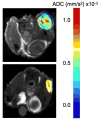Magnetic resonance in the era of molecular imaging of cancer
- PMID: 21524870
- PMCID: PMC3285504
- DOI: 10.1016/j.mri.2011.02.003
Magnetic resonance in the era of molecular imaging of cancer
Abstract
Magnetic resonance imaging (MRI) has played an important role in the diagnosis and management of cancer since it was first developed, but other modalities also continue to advance and provide complementary information on the status of tumors. In the future, there will be a major continuing role for noninvasive imaging in order to obtain information on the location and extent of cancer, as well as assessments of tissue characteristics that can monitor and predict treatment response and guide patient management. Developments are currently being undertaken that aim to provide improved imaging methods for the detection and evaluation of tumors, for identifying important characteristics of tumors such as the expression levels of cell surface receptors that may dictate what types of therapy will be effective and for evaluating their response to treatments. Molecular imaging techniques based mainly on radionuclide imaging can depict numerous, specific, cellular and molecular markers of disease and have unique potential to address important clinical and research challenges. In this review, we consider what continuing and evolving roles will be played by MRI in this era of molecular imaging. We discuss some of the challenges for MRI of detecting imaging agents that report on molecular events, but highlight also the ability of MRI to assess other features such as cell density, blood flow and metabolism which are not specific hallmarks of cancer but which reflect molecular changes. We discuss the future role of MRI in cancer and describe the use of selected quantitative imaging techniques for characterizing tumors that can be translated to clinical applications, particularly in the context of evaluating novel treatments.
Copyright © 2011 Elsevier Inc. All rights reserved.
Figures





References
-
- Pruessmann KP, Weiger M, Scheidegger MB, Boesiger P. SENSE: sensitivity encoding for fast MRI. Magn Reson Med. 1999;42:952–62. - PubMed
-
- Lustig M, Donoho D, Pauly JM. Sparse MRI: The application of compressed sensing for rapid MR imaging. Magn Reson Med. 2007;58:1182–95. - PubMed
-
- Robitaille PM, Abduljalil AM, Kangarlu A. Ultra high resolution imaging of the human head at 8 tesla: 2K × 2K for Y2K. J Comput Assist Tomogr. 2000;24:2–8. - PubMed
-
- Molecular Imaging Center of Excellence, Society of Nuclear Medicine. see http://www.molecularimagingcenter.org.
-
- Atkinson AJ, Jr, Colburn WA, DeGruttola VG, DeMets DL, Downing GJ, Hoth DF, Oates JA, Peck CC, Schooley RT, Spilker BA, Woodcock JW, Zeger SL. Biomarkers and surrogate endpoints: Preferred definitions and conceptual framework. Clin Pharmacol Ther. 2001;69:89–95. - PubMed
Publication types
MeSH terms
Substances
Grants and funding
- R01 CA138599/CA/NCI NIH HHS/United States
- R01 CA109106/CA/NCI NIH HHS/United States
- R01 CA140628/CA/NCI NIH HHS/United States
- K25 CA127349/CA/NCI NIH HHS/United States
- U24 CA126588/CA/NCI NIH HHS/United States
- R00 CA127599/CA/NCI NIH HHS/United States
- CA145138/CA/NCI NIH HHS/United States
- CA138599/CA/NCI NIH HHS/United States
- EB000214/EB/NIBIB NIH HHS/United States
- CA127599/CA/NCI NIH HHS/United States
- CA142565/CA/NCI NIH HHS/United States
- CA128323/CA/NCI NIH HHS/United States
- K99 CA127599/CA/NCI NIH HHS/United States
- CA140628/CA/NCI NIH HHS/United States
- CA109106/CA/NCI NIH HHS/United States
- U01 CA142565/CA/NCI NIH HHS/United States
- CA127349/CA/NCI NIH HHS/United States
- P50 CA128323/CA/NCI NIH HHS/United States
- R01 EB000214/EB/NIBIB NIH HHS/United States
- R01 CA129961/CA/NCI NIH HHS/United States
- CA129961/CA/NCI NIH HHS/United States
- RC1 CA145138/CA/NCI NIH HHS/United States
- K25 CA168936/CA/NCI NIH HHS/United States
LinkOut - more resources
Full Text Sources
Other Literature Sources
Medical

